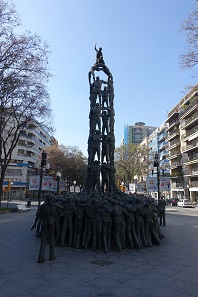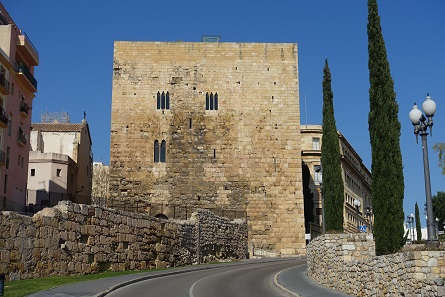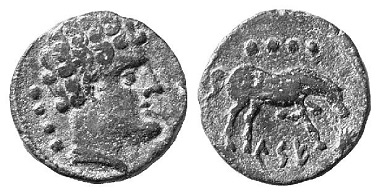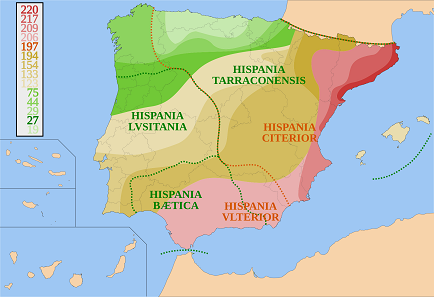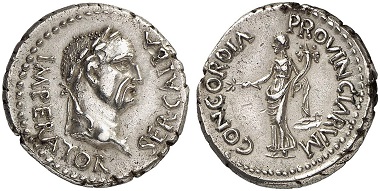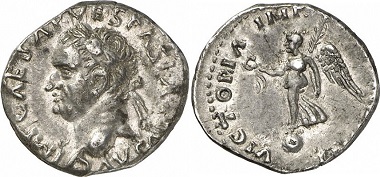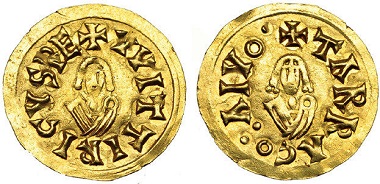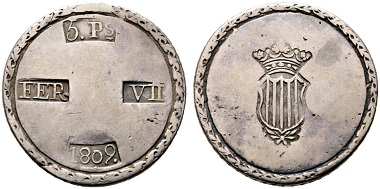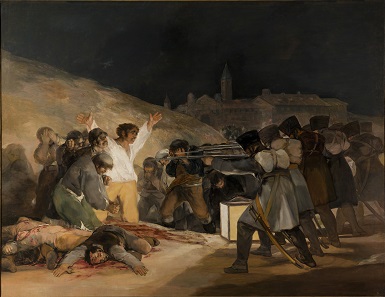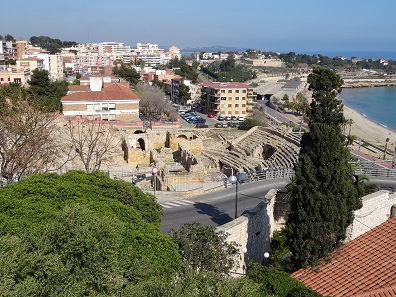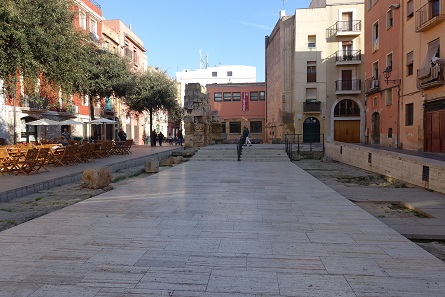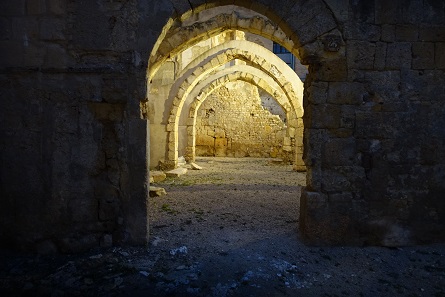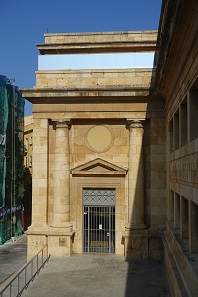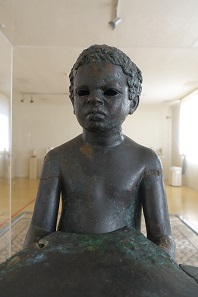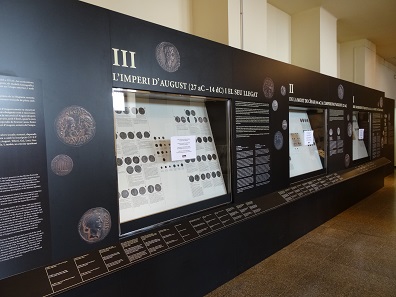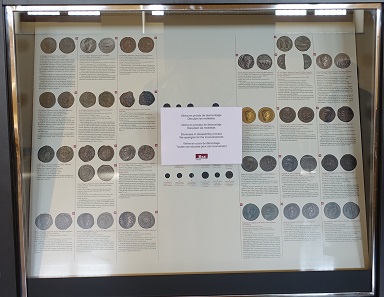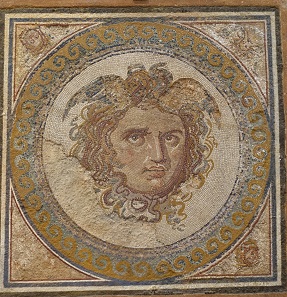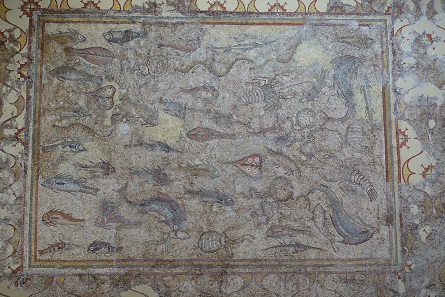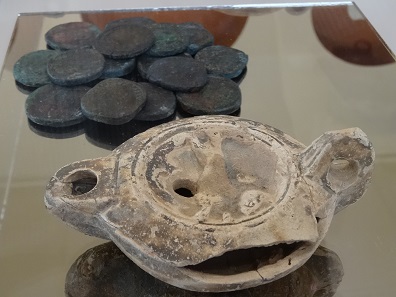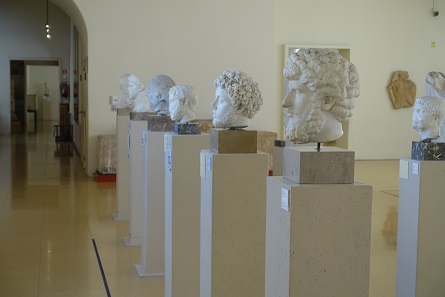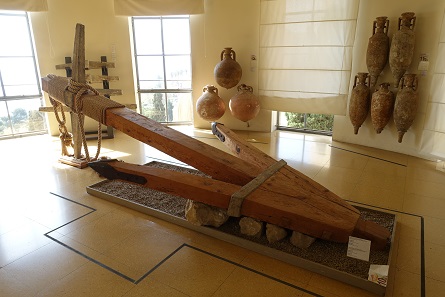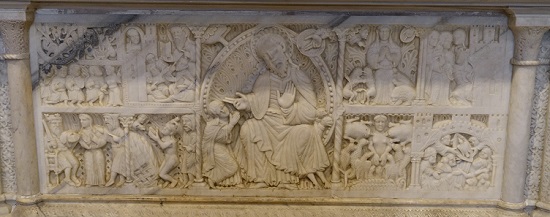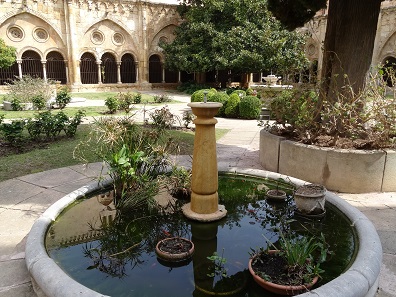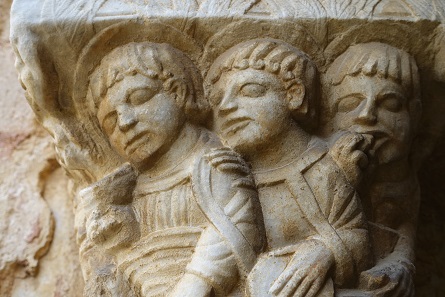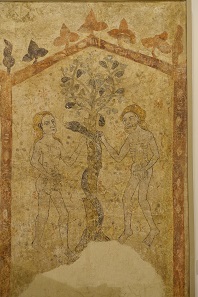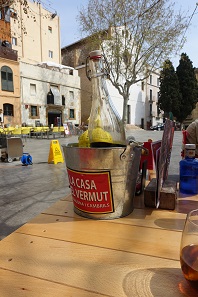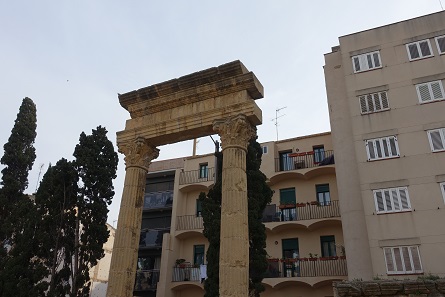by Ursula Kampmann
translated by Teresa Teklic
May 11, 2017 – Yes, you can find travel agencies which feature Tarragona in their programme. But it takes a long time to find them! Tarragona is the hidden gem among the Spanish cities which boast of their World Heritage status. With a picturesque (and extremely nourishing) old town (at least at night), with Roman ruins, which are as good as any, with a cathedral and a cloister, which is worth every detour, Tarragona has become one of my favourite Spanish cities.
Kese, probably the Celtic settlement which preceded Tarraco. Drachm. The reverse bears an Ibero-Spanish inscription with the city’s name. From Gorny & Mosch auction sale 126 (2003), No. 1005.
Monday, March 20, 2017
We only get going by 10.00 am and are shocked by the heavy traffic on the highway. But as soon as we’ve passed Montpellier the roads clear and by the time we pass the Spanish border they are empty but for us. We circumnavigate Barcelona and arrive in Tarragona at around 2.30 pm.
We find our hotel despite the fact that it is not where our satnav says it is. It’s a brand-new business hotel as you can find them all over Europe these days. And it has a restaurant! Which is, believe it or not, open as early as March, but unfortunately only in the evening. So we rush off towards the city with empty stomachs.
The human pyramids, which are a folk tradition in Catalonia, have their origins in Tarragona. Photo: KW.
Our route leads us across one of these beautifully spacious ramblas as you can only find them in Spain. Yet the pedestrian highway was so empty in the early afternoon that the only people we saw were made of bronze and reminding us that the Catalonian national sport, forming human pyramids, originated in Tarragona.
Torre del Pretori. Rebuilt several times, this tower goes back to the praetorium in which the governor of the province resided. Photo: KW.
There are no tourists. Not in groups, not alone. And that even though Tarragona, with all its Roman ruins, is a UNESCO World Heritage Site.
Kese. Triens, 120-20 BC. From Künker auction sale 97 (2005), No. 76.
Even before Roman times, there was a Celtic settlement where Tarragona is today. Its name is debated. Livy mentions a place called Cissis, Polybius calls it Kissa. If that’s identical with Tarraco? After all, Livy distinguishes between Cissa and Tarraco. On the other hand, coins with the Ibero-Spanish inscription Kese are mainly found in Tarragona. So it is widely accepted today that the two places are identical.
This map shows that the Romans didn’t conquer the Iberian peninsula in a day. Source: HansenBCN / Wikipedia. CC BY-SA 3.0.
The Romans noticed Tarraco when Publius Cornelius Scipio landed there in 217 to organize the resistance against Hannibal. The population of Tarragon seems to have been loyal and the location proved suitable as a base camp for the conquest of Spain. And when the first two Roman provinces were founded on Spanish ground in 197 BC, Tarraco became the capital of Hispania citerior.
Galba, 68-69. Denarius, 68, unknown mint in Spain (Tarraco?). From Künker auction sale 280 (2016), No. 513.
Whether Caesar or Augustus promoted the city to colony? That question remains unsettled but at least we know that Augustus stayed in Tarraco longer and that the city flourished under him. One even minted coins with the inscription CVT, but they are in such bad condition that I am going to spare you the sight. Instead you see a denarius of Galba, probably minted in Tarraco.
Remember that Galba was the governor of this province when his soldiers declared him emperor. The senate recognized him on June 8, 68, in Nero’s stead. Galba’s coins with the emperor’s title, presumably minted in Tarraco, must date back to this time.
Vespasian, 69-79. Denarius, 69-70, Tarraco. From Gorny & Mosch auction sale 186 (2010), 1951.
Galba couldn’t hold his ground against Otho in Rome. Otho lost to Vitellius and Vitellius to Vespasian, who found himself facing the challenge of refilling the treasury, which was empty after the civil war and the Year of the Four Emperors. To that end he is said to have granted all of Spain Roman citizenship. That made levying taxes more effective…
Hadrian, 117-138. Sesterce, 134-138. Rv. Hispania with branch. The usual small rabbit is missing. From Gorny & Mosch auction sale 240 (2016), No. 502.
Hadrian apparently came to Tarraco in the winter of 122/3 and held a “conventus”, something which the tourist office of the city still exploits today (not the conventus of course, but Hadrian’s visit).
Witeric. Tremissis, Tarracona. From Jesus Vico auction sale 146 (2016), 400.
Sometime around 472 less welcome guests arrived in Tarragona. The Visigoths conquered the city. They didn’t have enough men to push out the local population and so life continued in its usual ways until the Moors conquered Tarragona in 716.
Tarragona remained under Islamic rule until 1117 before being conquered by the dukes of close-by Barcelona and slowly dissolved into the rest of Spain due to several dynastic relations.
Tarragona. 5 Pesetas 1809. From Rauch auction sale 101 (2016), No. 1081.
Tarragona was to mint coins once more, siege money this time, which testifies to the French siege between 1809 and 1811.
The historical background is the annexation of the Iberian Peninsula by Napoleon. While the king, with his family, left the country pretty cowardly and abdicated in favour of Napoleon’s brother, the Spanish fought with such grim determination against the French occupying forces that a new word was coined for their style of combat: guerrilla warfare.
Execution of the resisters on May 3, 1808, in Madrid, by Francisco Goya. Museo del Prado, Madrid.
In the course of the military conflict Tarragona, as an important seaport, was occupied by France. The battle for the city began on May 5, 1809, and ended with the storming of the city on June 8, 1811. It culminated in a massacre, which cost thousands of lives. Louis Gabriel Suchet, who was responsible for the action, was rewarded for his achievements with the baton.
The war only ended in 1814 with the capitulation of Napoleon. While historians tend to say that the invasion of Russia was the beginning of the end of Napoleon’s rule, the Corsican thought differently: “It was the Spanish War which defeated me. All my misfortunes can be traced back to this fatal knot.”
The Roman theatre of Tarragona. Photo: KW.
While there are no remnants of the siege in Tarragona, you literally stumble across Roman ruins with every step you take.
Remnants of a Roman street, the very modest leftovers of an old city wall, and to the left a bar that was (o wonder!) open. Photo: KW.
And with every second step you take you stumble across a restaurant, a bar, or a café, but unfortunately all of those are closed on a Monday afternoon at 3.30 pm. But finally we are able to locate an open inn at an idyllic square! It’s a vermouth bar. If you wonder why so many bars in Spain specialize in vermouth, the internet has answers for you. Apparently, since the crisis in 2008 the new poor have withdrawn to the cheap bars, which offered vermouth along with free tapas. Vermouth has 22 volume per cent, and one or two little glasses are enough to make you so happy that you forget about everything else. Cheap fun. By now this trend has reached the upper classes. And that’s why the classy bars today offer a great variety of vermouth served with tapas (which are of course not free anymore).
Technically tapas are small and manageable, but if you order enough of them they can be filling just as well. We enjoy local cheese, exquisite ham from the Iberian pig, pickled mussels of unparalleled quality and drink (a little too much) vermouth. When we order the cheque we can’t believe it at first. Because it’s so cheap that we couldn’t even have ordered a pizza (without a beverage!) in Switzerland for the money.
Look at the lighted remains of an old synagogue. Photo: KW.
Pretty tipsy we made our way back to the hotel, past many Roman ruins, a cathedral, and a few medieval ruins, which we are saving for tomorrow. Enough vermouth in your stomach helps against even the greatest interest in Roman culture. Plus, we’ve travelled 1,200 km in two days and traversed numerous climate zones, a good excuse to call it a day.
The archaeological museum. Photo: KW.
Tuesday, March 21, 2017
Our first destination in the (relatively) early morning brings us to the archaeological museum, a definite highlight.
Compilation of all excavation finds from the theatre of Tarragona. Photo: KW.
A friendly museum attendant invites us to see a 10-minute film about the Roman Tarragona. She especially puts it on for us – and in English on top of things. Of course we think that a very good idea, until we realize that the advertised film consists of a staged dialogue between Hadrian and a potential pen friend. Imagine the sorry effort as a mash-up of Marguerite Yourcenar and Hollywood with a pinch of children’s programme.
One of the exhibition highlights: A lamp base in the shape of a little slave with Negroid features from the 2nd century AD. Found in the harbour area of Tarragona. Photo: KW.
We don’t come up with a good excuse to leave the cinema early. So we endure the film and learn that Hadrian visited the city once, that it’s a city of eternal spring, and that it used to be the capital of Hispania Tarragonensis. At least that’s more than the “Lonely Planet” travel guide offers. Since historical background information apparently is not on the list of expectations that the average buyer brings to his travel guide.
A look at the comprehensive coin exhibition. Photo: KW.
In the basement of the museum we discover a comprehensive coin exhibition, and a good one on top of that! We’re thrilled. With huge magnifications and detailed texts! What an appreciation of numismatics!
A coin exhibition without coins. That’s one way to go. Photo: KW.
The only flaw: The coins have been removed from all four show cases for no obvious reason. Anyway, what matters is the good intention!
A delicate mosaic with a representation of Medusa. Photo: KW.
The remaining three floors house many surprisingly good mosaics.
A mosaic with a great number of different marine animals. Photo: KW.
Big favourite of all classes is a mosaic with a great number of different marine animals, which are identified with enthusiasm especially by the younger pupils.
An ancient savings box. Photo: KW.
We declare an oil lamp, which has been repurposed into a savings box by adding a slot, our favourite numismatic object. Archaeologists even found countless sesterces in it.
A series of emperor portraits. In the foreground, Lucius Verus. Photo: KW.
Plus, there are several emperor portraits, partly even pretty good ones.
Reconstructed Roman anchor. Photo: KW.
We admire a reconstructed Roman lead anchor, which shows what the purpose behind the commonly found leaden cross beam originally was. Absolute highlight of the exhibition is “El Negret”, the little black one, a bronze statue of a boy with Negroid features whose shape is wonderfully detailed. He must have once carried oil lamps on his tray to light up a villa.
The Cathedral of Saint Thecla. An absolute must-do if you visit Tarragona. Photo: KW.
There are two definitive highlights in Tarragona: The countless Roman ruins and the phenomenal Cathedral of Saint Thecla. On the outside it looks nice, but not really like anything special.
A small doggie dragon – the unofficial name we have for dragon monsters which are so cute that you just find it unfair if they’re slain by a mean saint. Photo: KW.
On the inside, however, the Cathedral of Saint Thecla turns into a major highlight, a medieval picture puzzle with thousands of small figures, statues, ornaments. There’s something to see everywhere you look.
Exalting music in God’s honour. Photo: KW.
You just can’t stop staring in amazement. Or, rather, we can’t stop staring in amazement because all the other people hurrying through the church seem to be so busy taking selfies that they don’t even see that the altar is more than a nice background.
Altar of St Thecla. Photo: KW.
It tells the story of Saint Thecla in unbelievable detail.
Romanesque predella. Photo: KW.
Cloister of the cathedral of Tarragona. A must-see! Photo: KW.
And then there’s the cloister! Not every capital is embellished, …
Capital in the cloister. Photo: KW.
…but the ones that are really are something special.
Rats carrying a cat to the grave. Capital in the cloister. Photo: KW.
Even my a-historical Lonely Planet economy version of a guide book mentions the infamous rat procession, a story adopted from the Physiologus. A crowd of rats solemnly carries a cat to the grave, which turns out to be less dead than assumed. It jumps off the bier and helps lots of rats to a much less solemn funeral in its stomach.
The awakened cat devours the rats. Photo: KW.
The fable found its way into the sacred space due to its Christian exegesis: Sins, so the moral of the story, are like cats. Just when you think they’re dead and gone, they come back to haunt you.
Early Gothic murals. Museum of the Cathedral of Tarragona. Photo: KW. Foto: KW.
Nobody enters the cathedral without paying admission. And the admission is not even cheap. But it’s worth every euro cent. The admission also covers the cloister and above all the many exhibition rooms. Tarragona does not only exhibit the usual liturgical objects (which this time, like nine out of ten times, is pretty boring), but a small three-room gallery with paintings, whose exhibits could keep up with those in the Munich Pinakothek or the Metropolitan Museum. Last but not least, there is an adjacent archaeological museum with Early Gothic murals.
I think we spent more than two hours in that church. How time flies!
If you see these ice buckets, keep away. It’s a tourist trap. Photo: KW.
Afterwards we are hungry and start playing “find a bar that’s open”. There seems to be only one and that is directly on the opposite side of the archaeological museum. It is called “La casa del vermut”. Remember that well! And don’t go in there when you’re in Tarragona.
First a grumpy waitress serves us the tapas we ordered, which not only cost twice as much as the ones from yesterday. Then we notice that the steamed mussels are ice cold. After we complain, we get the same pot of mussels back two minutes later – this time microwave-heated. The tiny portions don’t satisfy our appetite either, but the prices are anything but tiny. There is no cheque either. When I start asking more vehemently, Missy suddenly forgets her English. Katalan solo.
Well, we’re tourists, so I guess we can get caught in a tourist trap once. Still hungry, we go looking for a café, where we fill our grumbling stomachs with sweet cake.
A forum outside of the town centre. In this place there once stood a gigantic basilica and a large temple. Photo: KW.
After the siesta we go exploring once more. You only realize just how big the Roman Tarragona was once you start walking in the different directions in which the excavations are. This time we don’t visit the high town but a middle-class district, which has a not-so-little forum with the remnants of a basilica, a temple, a few streets, and several insulae. Nothing exciting, but at least they didn’t superstruct it – that’s nice.
The day comes to an end. And so does our stay in Tarragona. And we realize that the city has much more to offer than we can explore in a day. There’s only one remedy: coming back!
In the next episode we visit Sagunto, where the Second Punic War began.
All episodes of the numismatic travelogue “To Spain!” are available here.






